Leadership in Healthcare: Analysis of Helen's Scenario and Action Plan
VerifiedAdded on 2021/09/30
|6
|978
|106
Report
AI Summary
This report examines leadership in healthcare, specifically focusing on a situational leadership style applied to a given scenario. It identifies the leader's strengths, such as adaptability and direct engagement, while also acknowledging shortcomings like the need for improved communication and conflict resolution. The report details a proposed action plan, including personal evaluation, community education programs, and stakeholder meetings to address issues like lack of equity and the need for specialist services, with a timeline spanning several weeks. The report emphasizes the importance of feedback, research, and stakeholder involvement for healthcare improvement, and concludes with a reflection on how the Leadership Assessment Tool can identify areas for development.
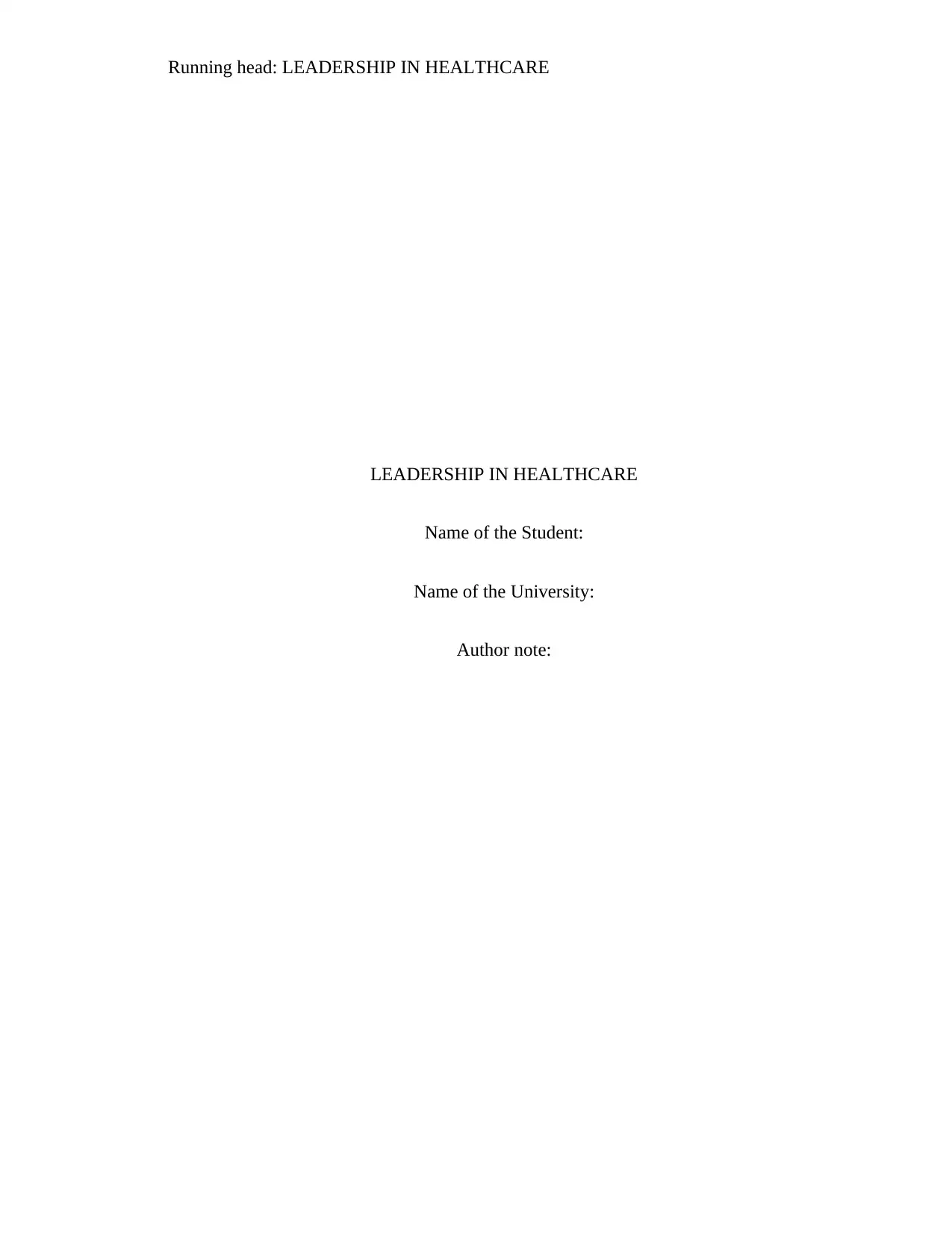
Running head: LEADERSHIP IN HEALTHCARE
LEADERSHIP IN HEALTHCARE
Name of the Student:
Name of the University:
Author note:
LEADERSHIP IN HEALTHCARE
Name of the Student:
Name of the University:
Author note:
Paraphrase This Document
Need a fresh take? Get an instant paraphrase of this document with our AI Paraphraser

1LEADERSHIP IN HEALTHCARE
Introduction
This report aims to identify the leadership style used, along with its advantages, with
relation to the scenario of Helen.
Leadership Style and Strengths
I would have used situational leadership style. The key strengths are that the leader is
highly receptive to the unique complex healthcare situation presented, along with exhibiting
direct engagement in the change process. Identifying and mitigating the key shortcomings of the
situation are the strengths of the situational leader (Lynch et al., 2018). As a situational leader I
would recognize the shortcomings of lack of unity and equity in healthcare resources along with
the need to incorporate specialist services in the vicinity. I will focus on being directly involved
with the healthcare system and associated stakeholders, along with working actively to advocate
for cultural acceptance, equity of resources, and promotion of health and prevention of diseases.
Response/Action Plan based on Self-Evaluation
I will respond by continuously evaluating and improving my personal qualities along
with obtaining feedback from my colleagues concerning my limitations. I will protest actively if
I notice hindrance of ethical acceptance and equity. My response would involve an action plan
which would include working actively with the citizens and stakeholders share the necessary
information across all platforms and engage in active leadership and delegation practices.
Considering the assessment tool, I will actively cooperate and support with my colleagues and
citizens and also improve these services through researching and obtaining feedback. In my
Introduction
This report aims to identify the leadership style used, along with its advantages, with
relation to the scenario of Helen.
Leadership Style and Strengths
I would have used situational leadership style. The key strengths are that the leader is
highly receptive to the unique complex healthcare situation presented, along with exhibiting
direct engagement in the change process. Identifying and mitigating the key shortcomings of the
situation are the strengths of the situational leader (Lynch et al., 2018). As a situational leader I
would recognize the shortcomings of lack of unity and equity in healthcare resources along with
the need to incorporate specialist services in the vicinity. I will focus on being directly involved
with the healthcare system and associated stakeholders, along with working actively to advocate
for cultural acceptance, equity of resources, and promotion of health and prevention of diseases.
Response/Action Plan based on Self-Evaluation
I will respond by continuously evaluating and improving my personal qualities along
with obtaining feedback from my colleagues concerning my limitations. I will protest actively if
I notice hindrance of ethical acceptance and equity. My response would involve an action plan
which would include working actively with the citizens and stakeholders share the necessary
information across all platforms and engage in active leadership and delegation practices.
Considering the assessment tool, I will actively cooperate and support with my colleagues and
citizens and also improve these services through researching and obtaining feedback. In my
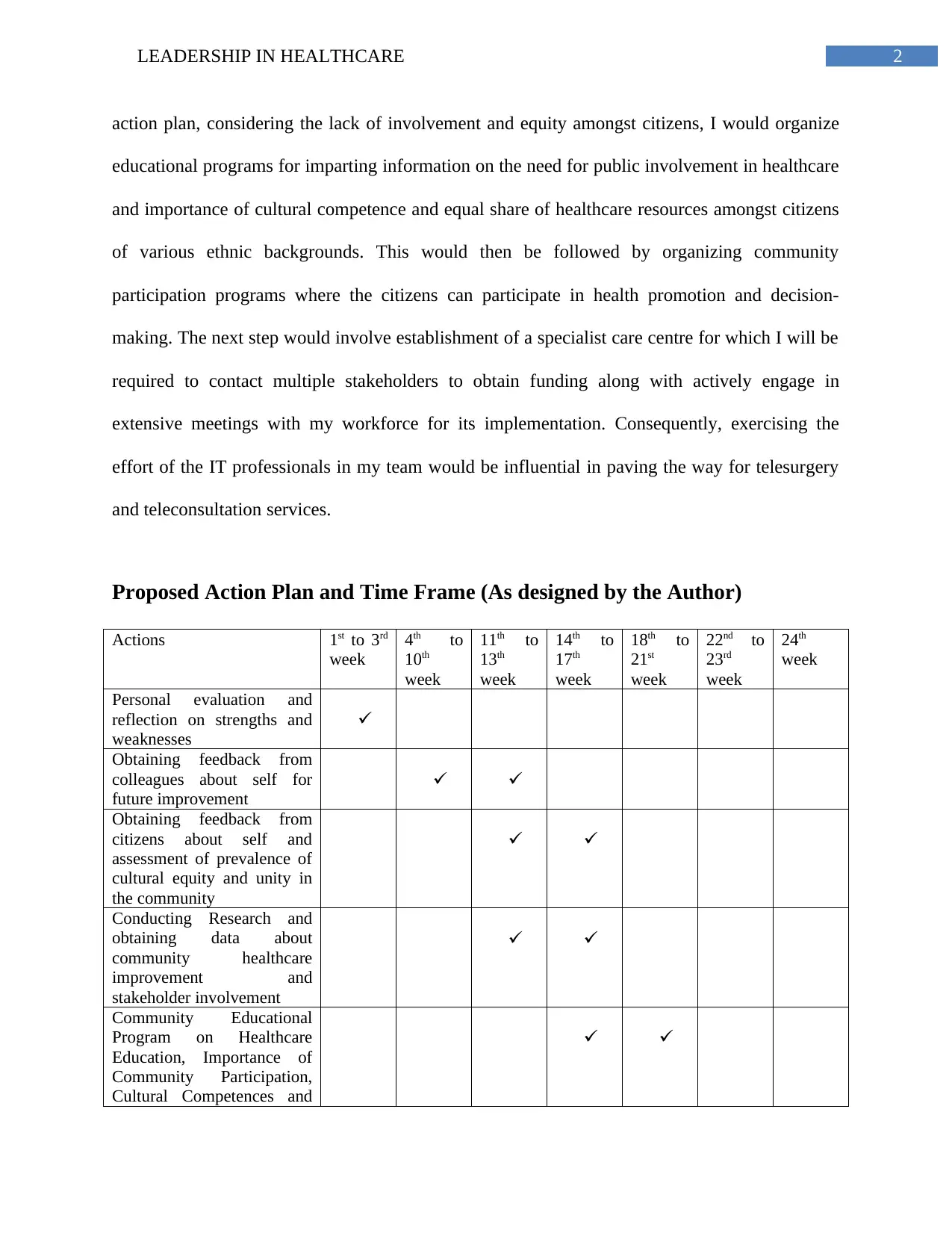
2LEADERSHIP IN HEALTHCARE
action plan, considering the lack of involvement and equity amongst citizens, I would organize
educational programs for imparting information on the need for public involvement in healthcare
and importance of cultural competence and equal share of healthcare resources amongst citizens
of various ethnic backgrounds. This would then be followed by organizing community
participation programs where the citizens can participate in health promotion and decision-
making. The next step would involve establishment of a specialist care centre for which I will be
required to contact multiple stakeholders to obtain funding along with actively engage in
extensive meetings with my workforce for its implementation. Consequently, exercising the
effort of the IT professionals in my team would be influential in paving the way for telesurgery
and teleconsultation services.
Proposed Action Plan and Time Frame (As designed by the Author)
Actions 1st to 3rd
week
4th to
10th
week
11th to
13th
week
14th to
17th
week
18th to
21st
week
22nd to
23rd
week
24th
week
Personal evaluation and
reflection on strengths and
weaknesses
Obtaining feedback from
colleagues about self for
future improvement
Obtaining feedback from
citizens about self and
assessment of prevalence of
cultural equity and unity in
the community
Conducting Research and
obtaining data about
community healthcare
improvement and
stakeholder involvement
Community Educational
Program on Healthcare
Education, Importance of
Community Participation,
Cultural Competences and
action plan, considering the lack of involvement and equity amongst citizens, I would organize
educational programs for imparting information on the need for public involvement in healthcare
and importance of cultural competence and equal share of healthcare resources amongst citizens
of various ethnic backgrounds. This would then be followed by organizing community
participation programs where the citizens can participate in health promotion and decision-
making. The next step would involve establishment of a specialist care centre for which I will be
required to contact multiple stakeholders to obtain funding along with actively engage in
extensive meetings with my workforce for its implementation. Consequently, exercising the
effort of the IT professionals in my team would be influential in paving the way for telesurgery
and teleconsultation services.
Proposed Action Plan and Time Frame (As designed by the Author)
Actions 1st to 3rd
week
4th to
10th
week
11th to
13th
week
14th to
17th
week
18th to
21st
week
22nd to
23rd
week
24th
week
Personal evaluation and
reflection on strengths and
weaknesses
Obtaining feedback from
colleagues about self for
future improvement
Obtaining feedback from
citizens about self and
assessment of prevalence of
cultural equity and unity in
the community
Conducting Research and
obtaining data about
community healthcare
improvement and
stakeholder involvement
Community Educational
Program on Healthcare
Education, Importance of
Community Participation,
Cultural Competences and
⊘ This is a preview!⊘
Do you want full access?
Subscribe today to unlock all pages.

Trusted by 1+ million students worldwide
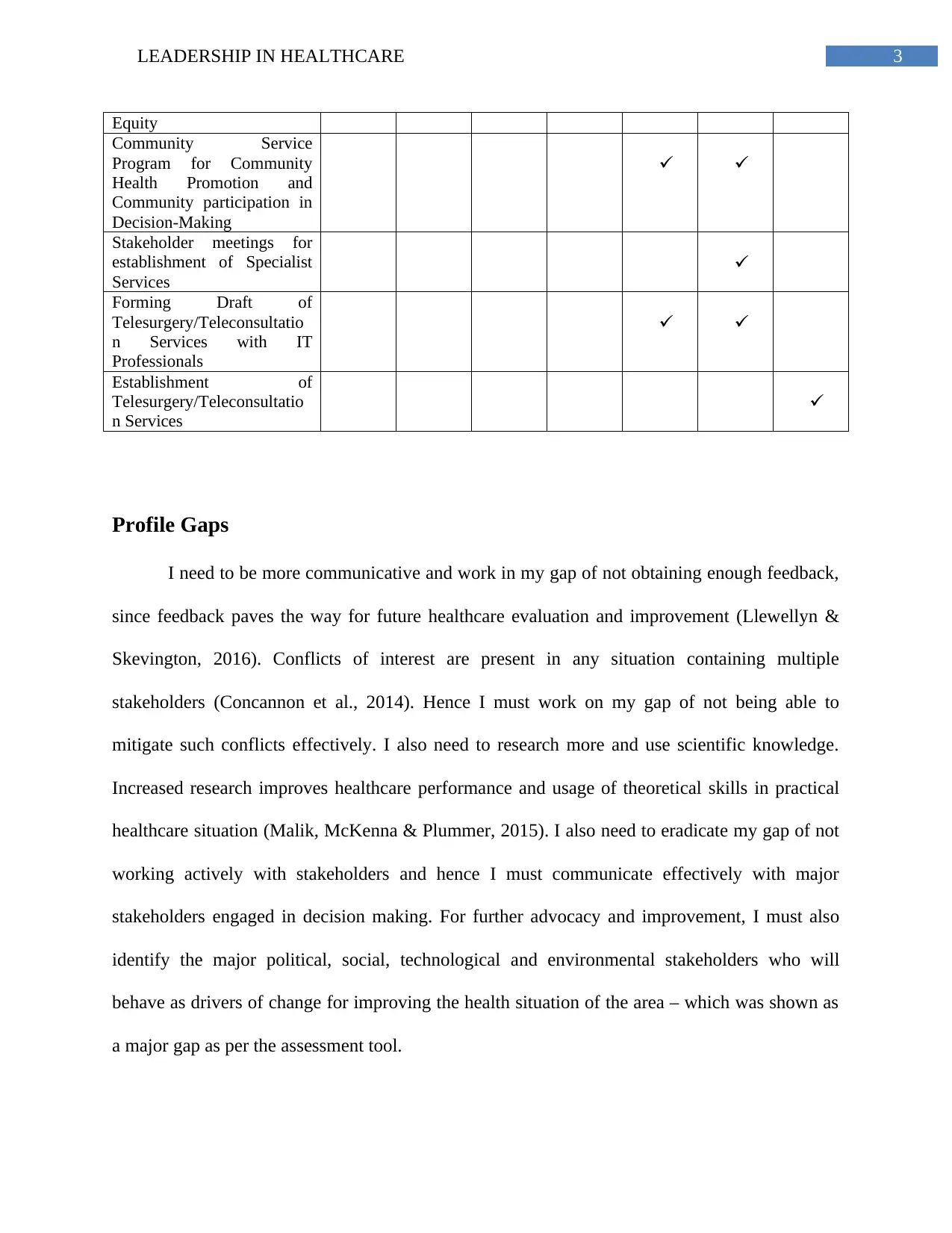
3LEADERSHIP IN HEALTHCARE
Equity
Community Service
Program for Community
Health Promotion and
Community participation in
Decision-Making
Stakeholder meetings for
establishment of Specialist
Services
Forming Draft of
Telesurgery/Teleconsultatio
n Services with IT
Professionals
Establishment of
Telesurgery/Teleconsultatio
n Services
Profile Gaps
I need to be more communicative and work in my gap of not obtaining enough feedback,
since feedback paves the way for future healthcare evaluation and improvement (Llewellyn &
Skevington, 2016). Conflicts of interest are present in any situation containing multiple
stakeholders (Concannon et al., 2014). Hence I must work on my gap of not being able to
mitigate such conflicts effectively. I also need to research more and use scientific knowledge.
Increased research improves healthcare performance and usage of theoretical skills in practical
healthcare situation (Malik, McKenna & Plummer, 2015). I also need to eradicate my gap of not
working actively with stakeholders and hence I must communicate effectively with major
stakeholders engaged in decision making. For further advocacy and improvement, I must also
identify the major political, social, technological and environmental stakeholders who will
behave as drivers of change for improving the health situation of the area – which was shown as
a major gap as per the assessment tool.
Equity
Community Service
Program for Community
Health Promotion and
Community participation in
Decision-Making
Stakeholder meetings for
establishment of Specialist
Services
Forming Draft of
Telesurgery/Teleconsultatio
n Services with IT
Professionals
Establishment of
Telesurgery/Teleconsultatio
n Services
Profile Gaps
I need to be more communicative and work in my gap of not obtaining enough feedback,
since feedback paves the way for future healthcare evaluation and improvement (Llewellyn &
Skevington, 2016). Conflicts of interest are present in any situation containing multiple
stakeholders (Concannon et al., 2014). Hence I must work on my gap of not being able to
mitigate such conflicts effectively. I also need to research more and use scientific knowledge.
Increased research improves healthcare performance and usage of theoretical skills in practical
healthcare situation (Malik, McKenna & Plummer, 2015). I also need to eradicate my gap of not
working actively with stakeholders and hence I must communicate effectively with major
stakeholders engaged in decision making. For further advocacy and improvement, I must also
identify the major political, social, technological and environmental stakeholders who will
behave as drivers of change for improving the health situation of the area – which was shown as
a major gap as per the assessment tool.
Paraphrase This Document
Need a fresh take? Get an instant paraphrase of this document with our AI Paraphraser
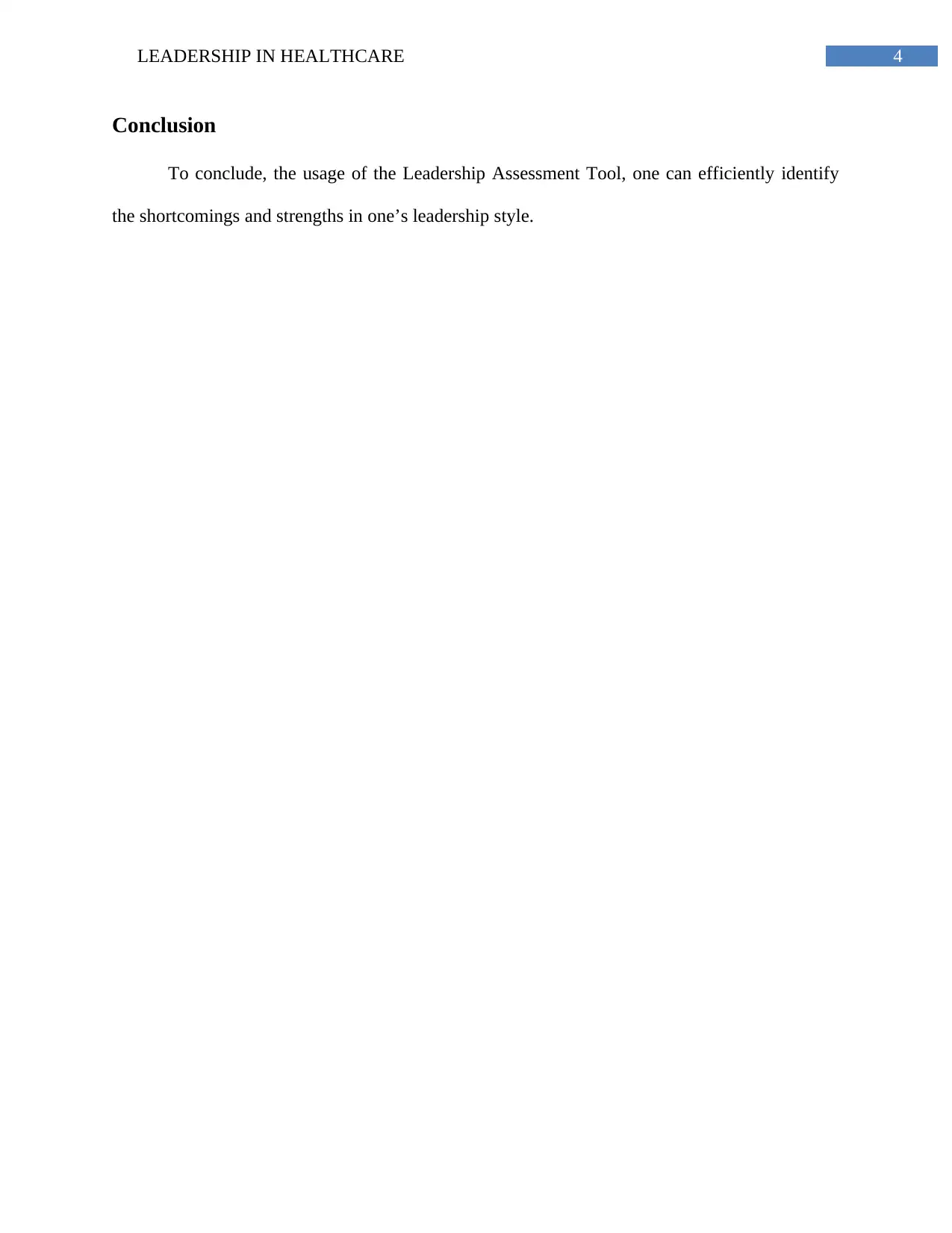
4LEADERSHIP IN HEALTHCARE
Conclusion
To conclude, the usage of the Leadership Assessment Tool, one can efficiently identify
the shortcomings and strengths in one’s leadership style.
Conclusion
To conclude, the usage of the Leadership Assessment Tool, one can efficiently identify
the shortcomings and strengths in one’s leadership style.
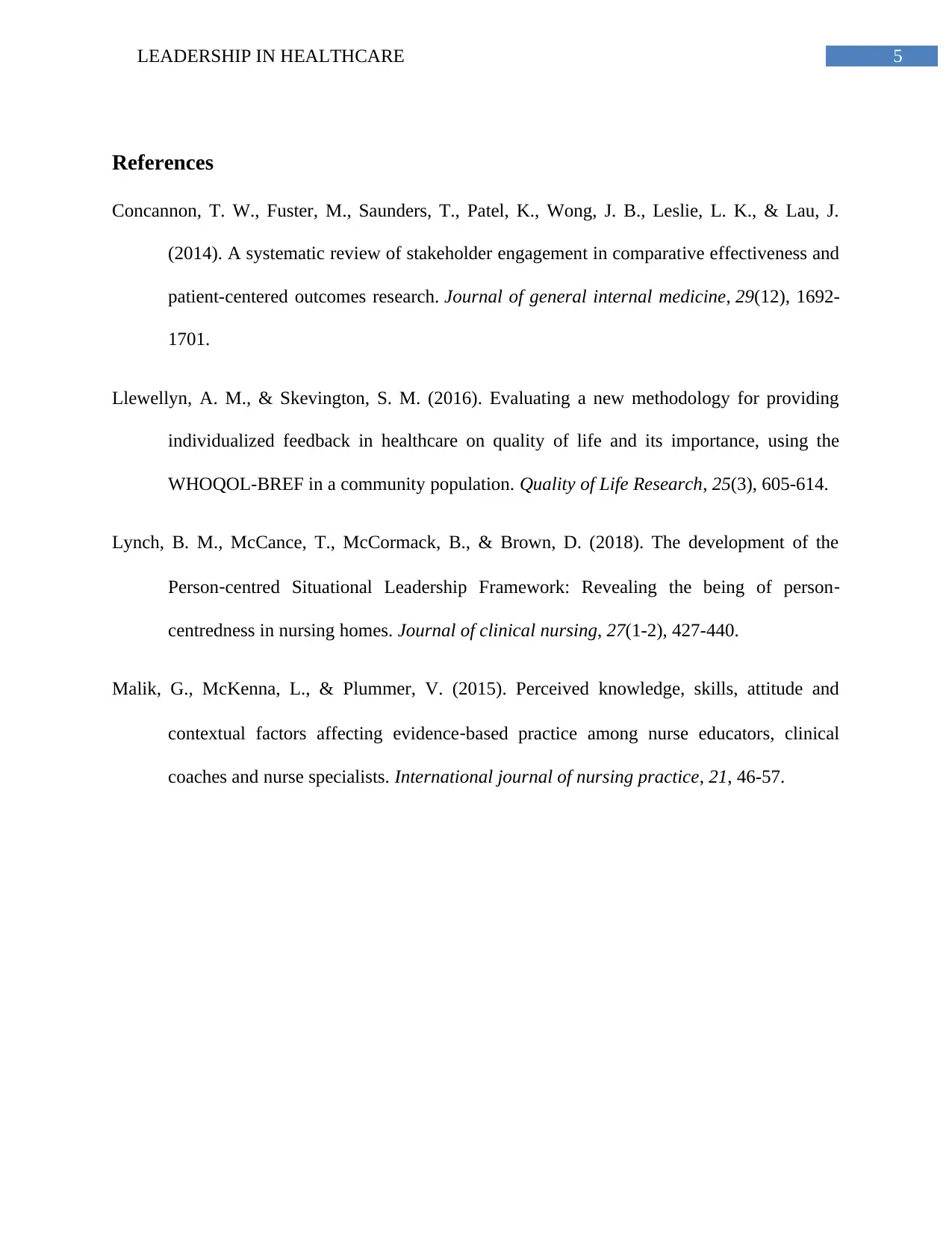
5LEADERSHIP IN HEALTHCARE
References
Concannon, T. W., Fuster, M., Saunders, T., Patel, K., Wong, J. B., Leslie, L. K., & Lau, J.
(2014). A systematic review of stakeholder engagement in comparative effectiveness and
patient-centered outcomes research. Journal of general internal medicine, 29(12), 1692-
1701.
Llewellyn, A. M., & Skevington, S. M. (2016). Evaluating a new methodology for providing
individualized feedback in healthcare on quality of life and its importance, using the
WHOQOL-BREF in a community population. Quality of Life Research, 25(3), 605-614.
Lynch, B. M., McCance, T., McCormack, B., & Brown, D. (2018). The development of the
Person‐centred Situational Leadership Framework: Revealing the being of person‐
centredness in nursing homes. Journal of clinical nursing, 27(1-2), 427-440.
Malik, G., McKenna, L., & Plummer, V. (2015). Perceived knowledge, skills, attitude and
contextual factors affecting evidence‐based practice among nurse educators, clinical
coaches and nurse specialists. International journal of nursing practice, 21, 46-57.
References
Concannon, T. W., Fuster, M., Saunders, T., Patel, K., Wong, J. B., Leslie, L. K., & Lau, J.
(2014). A systematic review of stakeholder engagement in comparative effectiveness and
patient-centered outcomes research. Journal of general internal medicine, 29(12), 1692-
1701.
Llewellyn, A. M., & Skevington, S. M. (2016). Evaluating a new methodology for providing
individualized feedback in healthcare on quality of life and its importance, using the
WHOQOL-BREF in a community population. Quality of Life Research, 25(3), 605-614.
Lynch, B. M., McCance, T., McCormack, B., & Brown, D. (2018). The development of the
Person‐centred Situational Leadership Framework: Revealing the being of person‐
centredness in nursing homes. Journal of clinical nursing, 27(1-2), 427-440.
Malik, G., McKenna, L., & Plummer, V. (2015). Perceived knowledge, skills, attitude and
contextual factors affecting evidence‐based practice among nurse educators, clinical
coaches and nurse specialists. International journal of nursing practice, 21, 46-57.
⊘ This is a preview!⊘
Do you want full access?
Subscribe today to unlock all pages.

Trusted by 1+ million students worldwide
1 out of 6
Related Documents
Your All-in-One AI-Powered Toolkit for Academic Success.
+13062052269
info@desklib.com
Available 24*7 on WhatsApp / Email
![[object Object]](/_next/static/media/star-bottom.7253800d.svg)
Unlock your academic potential
Copyright © 2020–2025 A2Z Services. All Rights Reserved. Developed and managed by ZUCOL.





